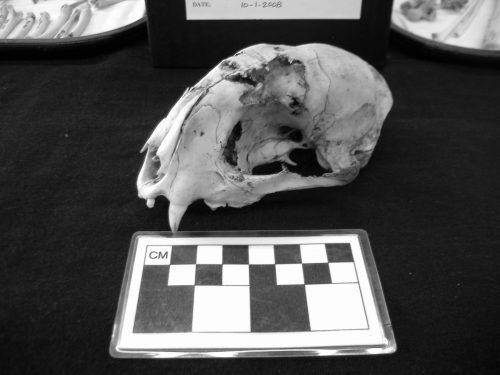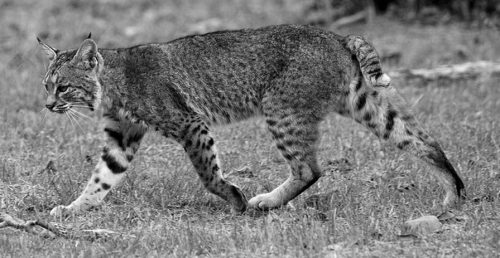Last summer, Dr. Karen Walker noticed a scatter of bones in the Northwest Pasture of the Calusa Heritage Trail, not far from the classroom building. She recognized the mandible as that of a bobcat.

This was exciting because I had seen tracks near the old Calusa Canal over the summer that looked like bobcat (a bobcat track looks like the track of a domestic cat, but is 2” wide). Karen asked me to collect as many of the bones as possible for use in the comparative collection of local fauna for the RRC. Comparative collections help us identify bones we find in archaeological sites, especially middens. I was fairly successful in my search, finding a representative sample of bones from the skeleton.
Assigned the catalogue number RRC-234, our cat was not too creatively dubbed “Bob.” Bobcats (Lynx rufus) are small native cats, weighing an average of 15 pounds, standing about 20” high and 33” long. They are orange- brown in color, sometimes fading to pale gray in winter. They have black spots and bars on their legs and rear, and a flat face with black bands radiating from their facial ruff, with slightly tufted ears. Also, not surprisingly, they have a short, “bobbed” tail. They are shy and nocturnal, and stalk and hunt small mammals and birds at night, killing them with a bite to break the neck. In South Florida, large bobcats have even been reported to take small deer.

source: Wikipedia Commonss
They have their kittens in May, usually two, but up to six in a litter. Bobcats are found throughout much of the continental U.S., and prefer a habitat of scrub, woods, and swamp, an environment that still describes much of Pine Island today. However, the range of a male bobcat can be up to 400 acres. Even with our extensive agricultural areas, natural bobcat habitat is at a premium on the island. Bobcats prefer to remain unseen by humans. The skeletal remains were processed at the classroom at the Trail with the help of lab volunteers Jessica Ater and Janelle Lowery. Cleaned and labeled, they will help us continue to learn about the natural history of Pine Island.
One thing we would like to find out is a possible cause of death. A set of teeth marks shows that part of the skull was crushed. Was this the cause of death, or the result of scavenging? And how long a life did “Bob” live roaming theCalusa Heritage Trail at night? Experts at the Florida Museum of Natural History may be able to tell us. Hopefully “Bob” has raised lots of family on Pine Island, and these beautiful felines will continue to live quietly among us.
This article was taken from the Friends of the Randell Research Center Newsletter Vol 7, No. 4. December 2008.